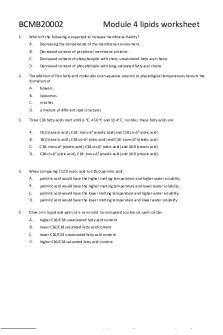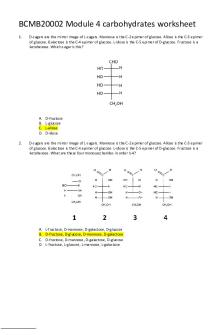Module 4 lipids worksheet with answers PDF

| Title | Module 4 lipids worksheet with answers |
|---|---|
| Course | Biochemistry And Molecular Biology |
| Institution | University of Melbourne |
| Pages | 3 |
| File Size | 172.1 KB |
| File Type | |
| Total Downloads | 96 |
| Total Views | 131 |
Summary
with answers...
Description
BCMB20002 1.
Module 4 lipids worksheet
Which of the following is expected to increase membrane fluidity? A.
Decreasing the temperature of the membrane environment.
B.
Decreased content of peripheral membrane proteins.
C.
Decreased content of phospholipids with short, unsaturated fatty acyl chains. Decreased content of phospholipids with long, saturated fatty acyl chains.
2.
The addition of free fatty acid molecules to an aqueous solution at physiological temperatures favours the formation of: A.
bilayers.
B.
liposomes. micelles.
D. 3.
a mixture of different lipid structures
Three C18 fatty acids melt at 69.6 °C, 45.0 °C and 13.4° C. In order, these fatty acids are: 18:0 (stearic acid), C18: trans-Δ9 (elaidic acid) and C18:cis-Δ9 (oleic acid)
4.
5.
B.
18:0 (stearic acid), C18:cis-Δ9 (oleic acid) and C18: trans-Δ9 (elaidic acid)
C.
C18: trans-Δ9 (elaidic acid), C18:cis-Δ9 (oleic acid) and 18:0 (stearic acid)
D.
C18:cis-Δ9 (oleic acid), C18: trans-Δ9 (elaidic acid) and 18:0 (stearic acid)
When comparing C12:0 lauric acid to C16:0 palmitic acid: A.
palmitic acid would have the higher melting temperature and higher water solubility.
.
palmitic acid would have the higher melting temperature and lower water solubility.
C.
palmitic acid would have the lower melting temperature and higher water solubility.
D.
palmitic acid would have the lower melting temperature and lower water solubility.
Olive oil is liquid and palm oil is semi solid. So compared to olive oil, palm oil has: A.
higher C16/C18 unsaturated fatty acid content
B.
lower C16/C18 saturated fatty acid content
.
lower C16/C18 unsaturated fatty acid content higher C16/C18 saturated fatty acid content
BCMB20002
Module 4 lipids worksheet
Questions 6-8 relate to docosapentaenoic acid shown below
6.
Docosapentaenoic acid is best described as: . B.
22:5Δ3,6,9,12,15 a polyunsaturated fatty acid 22:5Δ7,10,13,16,19 a saturated fatty acid 22:5Δ7,10,13,16,19 a polyunsaturated fatty acid
D. 7.
22:5Δ3,6,9,12,15 a saturated fatty acid
Docosapentaenoic acid is an: omega-3 fatty acid
8.
B.
omega-5 fatty acid
.
omega-6 fatty acid
D.
omega-7 fatty acid
Docosapentaenoic acid has: A.
all cis double bonds and is unnatural all cis double bonds and is naturally occurring
C.
mixed cis and trans double bonds and is unnatural
D.
all trans double bonds and is unnatural
BCMB20002
Module 4 lipids worksheet
Questions X-Y related to the hydropathy plot of a membrane protein shown below. alpha helices membrane layer
after membrane layer= inside the cell
9.
The protein is likely to contain: .
10.
7 transmembrane α-helices
B.
a membrane-spanning pore composed of 7 β-strands
C.
a large 250-residue folded domain
D.
a 100-residue C-terminal region outside the cell
Will the N- and C-termini of this protein will be: A.
on the same side of the membrane bilayer on opposite sides of the membrane bilayer
11.
C.
N-terminus outside and C-terminus outside
D.
N-terminus inside and C-terminus outside
The P-type ATPases are: A.
Carrier proteins that facilitate passive transport Active transporters that are driven by ATP-hydrolysis
12.
C.
Passive transporters that are driven by ATP-hydrolysis
D.
Carrier proteins that can transport molecules against a concentration gradient
Oxygen enters cells: via diffusion across membranes B.
on haemoglobin via large channels through cell membranes
C.
through facilitated passive transport by a specific carrier protein
D.
by active transporter that exchanges one CO2 for one O2 molecule...
Similar Free PDFs

Protein Worksheet with Answers
- 4 Pages

Module 4 Worksheet
- 8 Pages

Module 4 Quiz Answers
- 1 Pages

2019 worksheet 5 with answers
- 3 Pages

M4Answers - module 4 answers
- 3 Pages

Module 4 Short Answers
- 2 Pages
Popular Institutions
- Tinajero National High School - Annex
- Politeknik Caltex Riau
- Yokohama City University
- SGT University
- University of Al-Qadisiyah
- Divine Word College of Vigan
- Techniek College Rotterdam
- Universidade de Santiago
- Universiti Teknologi MARA Cawangan Johor Kampus Pasir Gudang
- Poltekkes Kemenkes Yogyakarta
- Baguio City National High School
- Colegio san marcos
- preparatoria uno
- Centro de Bachillerato Tecnológico Industrial y de Servicios No. 107
- Dalian Maritime University
- Quang Trung Secondary School
- Colegio Tecnológico en Informática
- Corporación Regional de Educación Superior
- Grupo CEDVA
- Dar Al Uloom University
- Centro de Estudios Preuniversitarios de la Universidad Nacional de Ingeniería
- 上智大学
- Aakash International School, Nuna Majara
- San Felipe Neri Catholic School
- Kang Chiao International School - New Taipei City
- Misamis Occidental National High School
- Institución Educativa Escuela Normal Juan Ladrilleros
- Kolehiyo ng Pantukan
- Batanes State College
- Instituto Continental
- Sekolah Menengah Kejuruan Kesehatan Kaltara (Tarakan)
- Colegio de La Inmaculada Concepcion - Cebu









